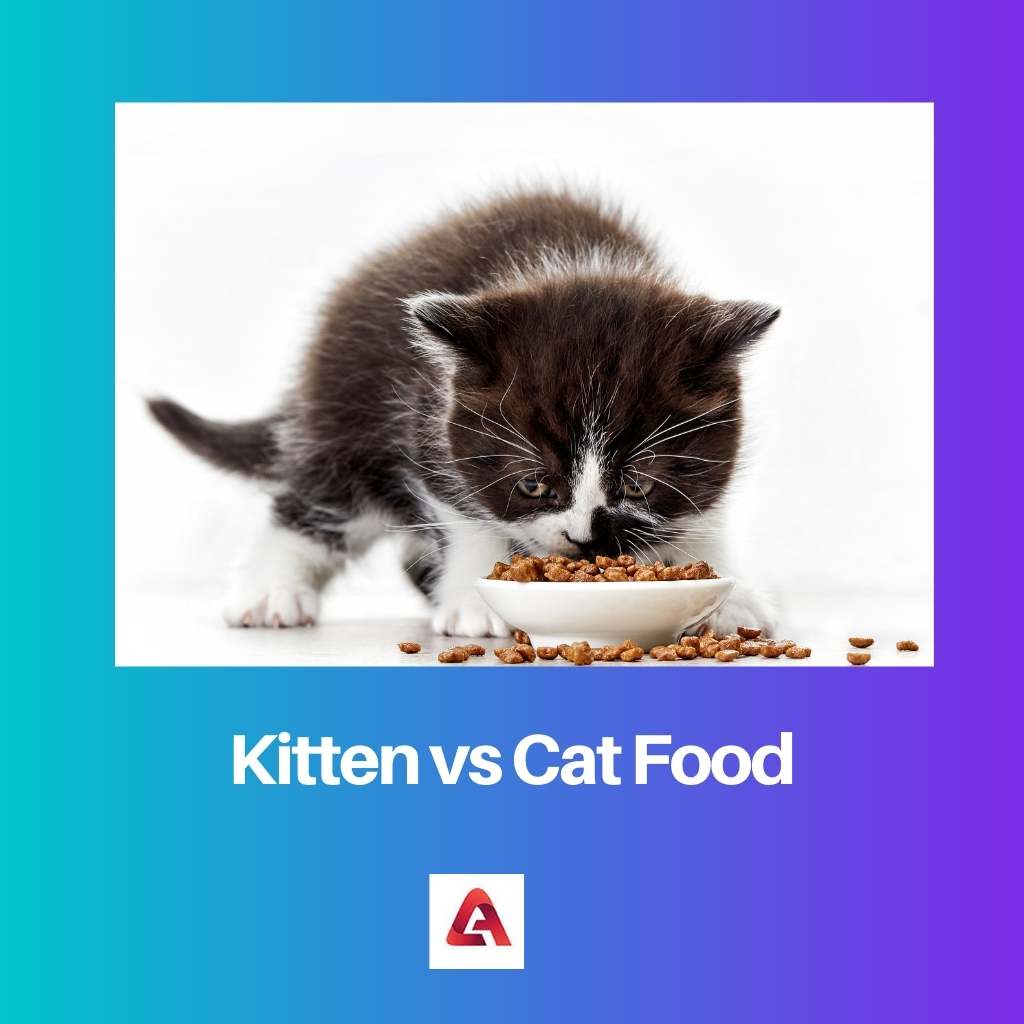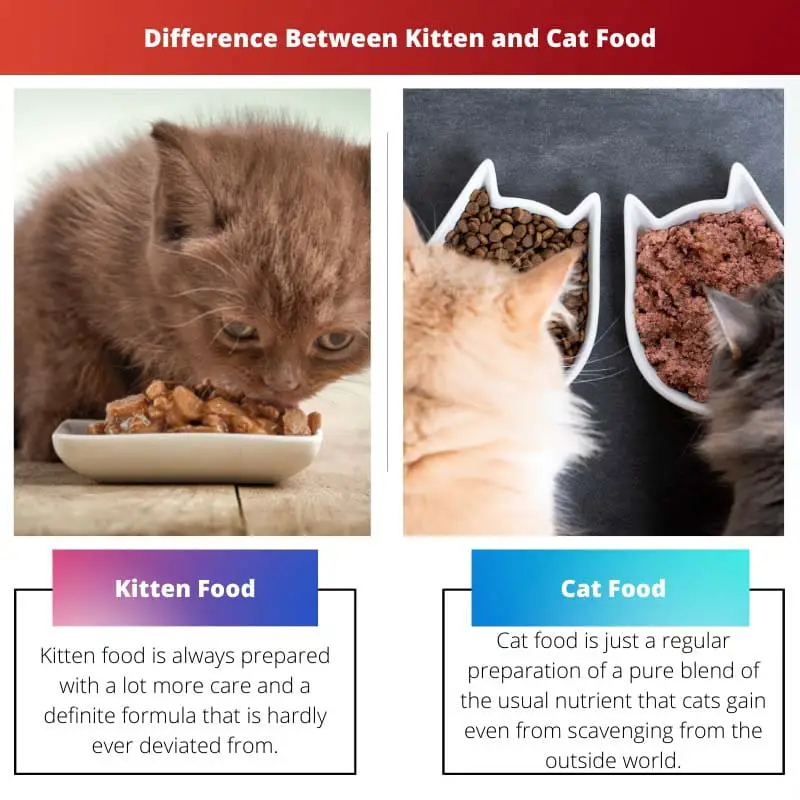Felis catus is the scientific name of the adorable and highly cuddly species, cat. Their young ones are called kittens. Just like how it is in humans, the babies can’t be given the food of the adults.
They need to be fed a different diet depending on the nutrient requirements of the kitten as based on the breed and environment.
Key Takeaways
- Kitten food contains higher protein, fat, and calories to support rapid growth and development in young cats.
- Cat food is formulated for adult cats with lower energy needs and focuses on maintaining a healthy weight.
- Feeding kittens adult cat food can lead to malnutrition while feeding adult cats kitten food can result in obesity.
Kitten vs Cat Food
Kitten food is specially formulated to meet the higher nutritional needs of young, growing cats, containing more protein and fat compared to adult cat food, which is designed to maintain health and meet the nutritional requirements of adult cats.

Kitten food is always prepared with a lot more care and a definite formula that is hardly ever deviated from.
These formulations are devised to create the perfect blend of carbohydrates, nutrients, and calories thereby helping the kittens gain the energy to satisfy the needs of the body that they spend in their activities and playful nature.
Cat food is just a regular preparation of a pure blend of the usual nutrient that cats gain even from scavenging from the outside world that they roam around and gather from.
They include a minimal amount of fat and calorie to not overly nourish the cats and hence limit their movements due to obesity.
The other nutrient content in cat food is also kept to the bare minimum and hence only enough to give strength to the cats and help in their daily activities.
Comparison Table
| Parameters of Comparison | Kitten Food | Cat Food |
|---|---|---|
| Can They Consume the Other’s Food | Cant consume cat food owing to malnutrition | Can have kitten food provided they have enough activities to keep them healthy or are nursing mothers |
| Protein Content | 30-45% | 26-40% |
| Fat Content | 8% | 5% |
| Essential Fatty Acid and Amino Acid Quantity | High | Low |
| Vitamin and Mineral Composition | Higher in calcium and phosphorous | Low in general |
What is Kitten Food?
Kittens are the offspring of cats (Felis catus). As an offering of all kingdoms and genera and animal families, kittens, too, require a specific nutrient food.
The kitten food formulas are formed to satisfy the rapid growth shown by a growing baby. Almost all species of animals show this growth rate in their young, and tender age is the prime time for nourishment.
Unlike cats, kittens need a large number of calories to be included in their regular meals.
This is to recharge the energy needs of the kitten that it might have spent in its regular and highly energy-consuming activities.
The general aura presented by kittens is that of a playful young one that keeps itself busy with a ton of outdoor playtime.
The growth rate and the playful livelihood manner of kittens encourage greater energy consumption within the body. This, in return, increases the nutrient content and the richness of the food it eats.
The kitten food made by manufacturers is always formulated to have a high amount of calories, fats, proteins, and carbohydrates.
This is also accompanied by the greater calcium and phosphorus-like minerals and vitamins that assist in the bodily development of the kittens, like their bones and teeth.
The diet planned by companies preparing kitten food makes it in such a way that it isn’t proving to be an issue for the digestive system.
Being in the starting stage of life, kittens have a sensitive and weak digestive system that won’t be able to digest heavily made food.
Being highly concentrated with many nutrients, kitten food tends to be pretty dense. This densely packed nutrient-rich food is prepared to keep in mind the kitten’s stomach capacity and digestive capabilities.
Kittens have a smaller tummy and hence can only consume little food. This increases the need for the food to be densely packed.
This is because as kittens only consume a small amount at a time, the need to give them all the nutrients required becomes greater.
The protein content in kitten food accepted internationally is about 30-45%, which is high considering it is being given to a baby being.
The general fat amount in kitten food used by manufacturers is within 8%. This is to provide a great growing feature to the kitten. The essential amino acids and fatty acids in kitten formulas are comparatively high for a baby.
This is to help in the growth of the internal organs and tissue development of the kitten.
Kittens can’t consume the food prepared for adult cats as they won’t get the proper nutrients needed and would become stunted or malnourished and underdeveloped adult cats.
About 30% of the energy requirement of the kitten is acquired from the food’s proteins, fats, and calories alone.
What is Cat Food?
Cats are the feline opposite of dogs, much loved and accepted as pets since ancient times.
Even since the time of ancient Egyptians, cats were considered as per royalty and given the best treatment. This includes the food given to them.
In Olden times, cats were given food prepared at home in a measured quantity. Recent times have changed it. Now a proper food content formula is prepared for cats that are followed internationally by all food manufacturers and creators.
Cats need food only to satisfy the required energy that it spends daily. They don’t require food to help them in their developmental and growth factors.
They have about 20-40% of protein content added to the factory-prepared cat food.
This is quite a normal amount of protein provided in the food preparation of an adult animal with the body dimensions and activities as that of a cat.
The fat percentage advised to be added to cat food is a standard 5%.
The more fat amount in cat food, the greater the fat accumulation in a cat’s body, leading to obesity and lack of movement.
A lower amino acid and fatty acid content are essential and are required from an outside source in cat food.
This applies to the accepted amount of minerals such as calcium and phosphorus in the food. A smaller quantity of vitamins is prescribed in cat food formulas.
The lower vitamins and minerals lead to lower chances of mineral accumulation in the body of the pets, which may lead to cell growth.
This can be the start of tumour-like growth and can be fatal to the pet.
Such low nutrient percentages in cat food are because they don’t have any growth requirements or developmental needs.
Cats are not prescribed to consume food meant for kittens, as the high nutrient content might lead to obesity in cats.
But that doesn’t mean that they can’t consume kitten food. Because kitten food is given to nursing cats or pregnant female cats, this is to meet the needs of the growing fetus within the mother.
Main Differences Between Kitten and Cat Food
- While the protein content specified for kitten food is 30-40%, the protein content advised for cats is quite low at 26-40% and is taken at the lower limit.
- The fat percentage advised for kitten food manufacturers is 8%, which for cat food is again a lower limit of only 5% to reduce the fat accumulation in the body in case of lack of activities.
- The usual vitamins and minerals that are considered to be added to kitten food are high when in comparison to the low amount added to cat food.
- Kittens have smaller stomachs, and therefore the food given to them is in small quantities. This shows that their food has to be densely packed with nutrients when compared to cats, who have a larger tummy and hence a bigger appetite.
- While kittens can’t eat cat food because they lack exact nutrient needs, cats can consume kitten food given the right amount of exercise and activities.

- https://www.ncbi.nlm.nih.gov/pmc/articles/PMC1250243/
- https://www.tandfonline.com/doi/abs/10.1111/j.2045-0648.2012.00182.x





I can’t help but find the descriptions of kitten food as ‘carefully formulated’ and cat food as ‘usual nutrient blends’ quite amusing. The anthropomorphization of pet food in this article adds a comical touch to an otherwise informative piece.
I agree, Wendy Hill. The personification of pet food as if it has feelings and intentions is an entertaining aspect of the article. It brings a lighthearted tone to the scientific comparison of feline nutrition.
It’s evident that the authors have delved deeply into the nutritional content of kitten and cat food, offering readers a comprehensive understanding of the specific nutrients required for each life stage. This is a valuable resource for cat owners seeking to optimize their pets’ diets.
This article excellently highlights the diverse nutritional needs of kittens and adult cats, offering valuable insights into the specific requirements of each life stage. It’s a well-researched and thorough comparison that provides useful guidance for cat owners.
The article fails to address the environmental and sustainability implications of the vast differences in nutritional composition between kitten and cat food. Considering the environmental impact of pet food production and consumption is an essential aspect that should have been included in the discussion.
This article provides a comprehensive and well-researched comparison between kitten and cat food, highlighting the nutritional differences and the specific needs of each. It’s a great resource for pet owners to ensure they are providing the best diet for their feline companions.
It’s clear that the authors have put a lot of effort into researching and presenting this information. It’s a very helpful guide for those looking to understand the differences between kitten and cat food.
I completely agree. The information provided here is valuable for cat owners, helping them make informed decisions about their pets’ nutrition.
While the article is informative, it seems to overlook the potential risks of overfeeding kittens with high-calorie food and underfeeding adult cats with low-nutrient food. A more balanced perspective on the risks associated with both types of diets would have been beneficial.
I see your point, Astevens. It’s important to consider the potential negative outcomes of feeding the wrong type of food to cats at different life stages. A more balanced discussion would enhance the article’s credibility.
I agree with Astevens. While the information provided is useful, a more critical examination of the potential drawbacks of both kitten and cat food diets would provide a more nuanced understanding for readers.